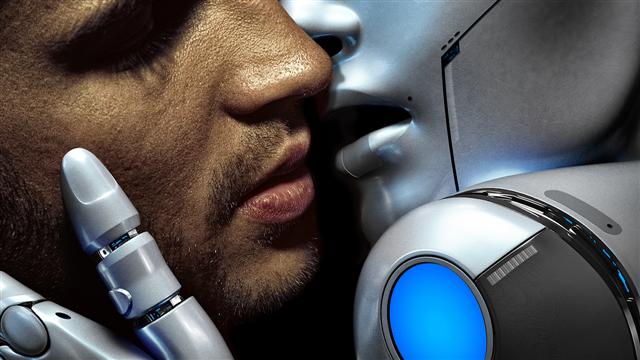
This Is What The Future Of Sex Will Look Like
What Does The Future Of Sex Look Like?
Ian Pearson is a career futurist who follows and predicts progress in technology, commerce, culture, politics, and the environment. However, he is perhaps the most well-known for his theories about the future of sex.
Pearson talked in-depth about the topic “The Rise of the Robosexuals,” a collaboratory paper with online sex retailer Bondara. In this study, he made some bold assertions, like:
- VR sex becoming as commonplace as regular porn viewing by 2030
- Most people will have sex toys that communicate with VR by 2035
- Some variation of robot sex will emerge in the homes of the wealthiest people by 2025
- Human-robot sex will surpass human-human by 2050
As you can imagine, his ideas have drummed up some controversy. But at the same time, it has people thinking ahead about the future of human sexuality and sexual pleasure.
So what does Pearson think the future of sex looks like? Let’s take a look.
NBIC-convergence and AI
You can’t talk about the future of sex without getting into the role of NBIC-convergence and AI. But what exactly are they?
“NBIC-convergence is the ongoing unification of nanotechnology, biotechnology, information technologies, and cognitive science. The developments in these fields not just complement each other – the fields are gradually merging. This convergence defines many aspects of the ongoing scientific and technological revolution.”
Alright, so what is “strong AI”?
First, you have to take a step back and understand more about artificial general intelligence (AGI). That’s a machine’s hypothetical ability to understand (or learn) the same cognitive things as people. AGI is the main focus for several AI researchers and a frequent subject in sci-fi and futures studies.
AGI is sometimes known as strong AI, but most academics save the phrase for machines that achieve consciousness. Many experts think it will be decades before today’s AI reaches AGI.
According to Pearson, strong AI could be totally sentient, have over two million emotions, an endless number of senses — and be either harmless or dangerous.
Some might find it unsettling, but when you think about how this can change the future of sex, it’s also exciting, especially when you see how scientists are using this technology in today’s sex toys to give users an even better sexual experience.
By learning more about what researchers are working on today, you can get a better idea of what the future of sex will look like.
Smart Sex Toys
When you consider how advanced sex toys have become, you have to wonder what the future of sex toys will look like. Take the Lioness vibrator, for example. It’s just one of many smart sex toys on the market right now (and it’s perfect for long-distance couples).
The company touts it as “the first and only smart vibrator that lets you see and improve your orgasms.” By allowing users to “see” what’s happening, users will be able to learn how to have better ones.
But how does this work?
The vibrator has sensors inside it that measure pelvic floor movements, which are one of the strongest signs for arousal and orgasms. As these muscles contract and relax during use, the sensors send the information to the accompanying app and show what made it more or less satisfying.
It’s not your mother’s vibrator, that’s for sure!
Pearson theorizes that this technology will be incorporated into androids to produce an ultra-high-quality sexual experience.
Robot Sex
Pearson is probably known most for his claim that human-robot intimacy will be commonplace by 2050. He’s adamant that the future of sex will not be the cold, soulless, isolating world people fear. Instead of diminishing human intimacy, he believes that robot sex will enhance it.
He predicts domestic androids will displace cars as the leading investment besides the house by then. Men and women will purchase androids based on their preferences and the features they can get within their budget.
Some people might develop an emotional connection with these robots, and yes, have sex with them. But if AI becomes as advanced as Pearson predicts, these androids will be capable of feeling emotion and crave sex with other robots or individuals.
Skin-Based Electronics
Skin-based electronics are where the bridge between humans and technology begin to merge. Pearson estimates that within this decade, we’ll see something called “active skin.”
Do you dream of experiencing that one night when you had the best sex of your life again? You can with active skin. Pearson told Maxim Magazine in a 2016 interview,
“If you can get nanotechnology downsized to the point where you can make electronic capsules about the same size as skin cells, you can plant them in the skin, that will allow you to connect to nerves. Then you can connect your peripheral nervous system to the IT, so you can record and replay sensations. And this is more 2020 technology than 2050 technology.”
Sensory-Enhanced VR
The future of virtual reality (VR) will strongly impact the future of sex.
In “The Rise of the Robosexuals,” Pearson theorizes that by 2030, “most people will have some form of virtual sex as casually as they browse porn today.” And by 2035, he believes sex toy-enhanced VR porn will be advanced enough for everyday use.
Right now, watching (and experiencing) porn through a VR headset is still a relatively new sensation. Even so, wire-free sex toys are already clouding the boundaries between real and virtual. These futuristic toys contain haptic feedback systems that react to videos in real-time, arousing the user’s body in the process.
Pearson speculates that the progression of VR will give users a chance to play out their wildest fantasies using custom AI avatar, with no one but the user being the wiser. On the other end, users could fulfill dreams with actual people either as themselves or as a fictional character in a new environment.
As he put it, “VR offers to combine the best of imagination and reality.”
Active Contact Lenses and Dream Linking
Remember when Google Glass was all the rage a few years ago? Did you know they were also working on a product called Google Smart Contact Lens? That was in 2015 — over two decades after Pearson wrote about active contact lenses in 1991.
But what do these high-tech contacts have to do with the future of sex?
Well, one idea Pearson discussed was Dream Linking, or “sleep VR.” He says that these lenses would allow you to see images — not just visualize them — with closed eyes.
When you drift off to sleep, these lenses — connected to a computer, of course — recognize when you enter the dream state, the things you see, and implant pictures or videos to supplement your dream.
Not only that, but these active lenses can connect your dreams to those of others dreaming simultaneously, where you could hypothetically hook up in your dreams. Throw in sex toys and active skin that work when you sleep, and you have the ultimate wet dream.
Biotechnology: Brining You Future Of Sex
Androids For Gender Play
Have you ever asked yourself what you would do if you were the other gender for one day?
Let’s say biotechnology reaches a point where humans can “fuse” with androids. Pearson speculates that by 2050, people could live inside android bodies.
It’s a generous timeline, but if it were the case, you would finally be able to answer that question!
There is a lot of gray area around this idea, but let’s have some fun since it’s only hypothetical.
A human-android fusion does offer some benefits besides offering a chance to live like the other gender for a day. It could give someone with a physical disability a chance to live without it. And older adults could use this tech to feel young again.
But if you want to stick with the gender-swap subject, it could allow trans individuals to live according to their actual gender. Considering there is still a lot of stigma around trans people, this would help improve many peoples’ wellbeing.
These “swaps” could be as brief as a day, or even permanent. New body, new life, right?
Pearson takes things a step further, predicting that while an individual inhabits an android, other people could use the body they left behind. He says that consciousness can be turned off and on like a switch, allowing the body to be vacated and rented out to other sexual partners.
It’s a little extreme and a little weird, but that’s just his take on the future of sex. We want to think that human-android beings would simply enhance peoples’ quality of life.




Leave a Comment